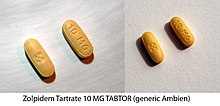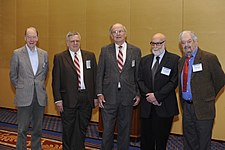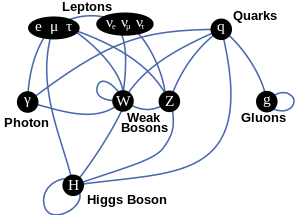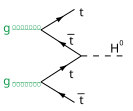Higgs boson
From Wikipedia, the free encyclopedia
The
Higgs boson or
Higgs particle is a proposed
elementary particle in the
Standard Model of
particle physics. The Higgs boson is named after
Peter Higgs who, along with others, proposed
the mechanism that
predicted such a particle in 1964.
[4][5][6] The existence of the Higgs boson and the associated
Higgs field explain why the other massive elementary particles in the standard model have their
mass. In this theory, the Higgs field has a non-zero field everywhere, even in its
lowest energy state.
Other massive elementary particles obtain mass through the continuous
interaction with this field (however, not all elementary particles have
mass). The Higgs field interaction is the simplest mechanism which
explains why some elementary particles have mass. The Higgs boson—the
smallest possible excitation of the Higgs field—has been the target of a long search in particle physics. One of the primary design goals of the
Large Hadron Collider at
CERN in
Geneva,
Switzerland—one
of the most complicated scientific instruments ever built—was to test
the existence of the Higgs boson and measure its properties.
Because of its role in a fundamental property of elementary
particles, the Higgs boson has been referred to as the "God particle" in
popular culture, although virtually all scientists regard this as a
hyperbole. According to the Standard Model, the Higgs particle is a
boson,
a type of particle that allows multiple identical particles to exist in
the same place in the same quantum state. Furthermore, the model posits
that the particle has no
intrinsic spin, no
electric charge, and no
colour charge. It is also very unstable, decaying almost immediately after its creation.
On 4 July 2012, the
CMS and the
ATLAS
experimental collaborations at the Large Hadron Collider announced that
they observed a new boson that is consistent with the Higgs boson,
noting that further data and analysis were needed before the particle
could be positively identified.
Overview
The existence of the Higgs boson was predicted in 1964 to explain the
Higgs mechanism
(sometimes termed in the literature the Brout–Englert–Higgs, BEH or
Brout–Englert–Higgs–Hagen–Guralnik–Kibble mechanism after its original
proposers
[7])—the mechanism by which elementary particles are given
mass.
[Note 2]
While the Higgs mechanism is considered confirmed to exist, the boson
itself—a cornerstone of the leading theory—had not been observed and its
existence was unconfirmed. Its tentative discovery in July
2012
may validate the Standard Model as essentially correct, as it is the
final elementary particle predicted and required by the Standard Model
which had not yet been observed via
particle physics experiments.
[8]
Alternative sources of the Higgs mechanism that do not need the Higgs
boson also are possible and would be considered if the existence of the
Higgs boson were to be ruled out. They are known as
Higgsless models.
The Higgs boson is named after
Peter Higgs, who in 1964 wrote one of three
ground-breaking papers alongside the work of
Robert Brout and
François Englert and
Tom Kibble,
C. R. Hagen and
Gerald Guralnik covering what is now known as the Higgs mechanism and described the related Higgs field and boson.
Technically, it is the quantum excitation of the
Higgs field, and the non-zero value of the ground state of this field, that give
mass to the other
elementary particles, such as
quarks and
electrons. The Standard Model completely fixes the properties of the Higgs boson, except for its mass. It is expected to have no
spin and no
electric or
colour charge, and it interacts with other particles through the
weak interaction and
Yukawa-type interactions between the various fermions and the Higgs field.
Because the Higgs boson is a very massive particle and decays almost immediately when created, only a very high-energy
particle accelerator can observe and record it. Experiments to confirm and determine the nature of the Higgs boson using the
Large Hadron Collider (LHC) at
CERN began in early 2010, and were performed at
Fermilab's
Tevatron
until its close in late 2011. Mathematical consistency of the Standard
Model requires that any mechanism capable of generating the masses of
elementary particles become visible at energies above
1.4 TeV;
[9]
therefore, the LHC (designed to collide two 7 TeV proton beams, but
currently running at 4 TeV each) was built to answer the question of
whether or not the Higgs boson exists.
[10]
On 4 July 2012, the two main experiments at the LHC (
ATLAS and
CMS) both reported independently the confirmed existence of a previously unknown particle with a mass of about
125 GeV/c2 (about 133 proton masses, on the order of 10
−25 kg),
which is "consistent with the Higgs boson" and widely believed to be
the Higgs boson. They cautioned that further work would be needed to
confirm that it is indeed the Higgs boson (meaning that it has the
theoretically predicted properties of the Higgs boson and is not some
other previously unknown particle) and, if so, to determine which
version of the Standard Model it best supports.
[1][2][3][11][12]
General description
In
particle physics,
elementary particles
and forces give rise to the world around us. Physicists explain the
behaviours of these particles and how they interact using the
Standard Model—a widely accepted framework believed to explain most of the world we see around us.
[13]
Initially, when these models were being developed and tested, it seemed
that the mathematics behind those models, which were satisfactory in
areas already tested, would also forbid elementary particles from having
any
mass, which showed clearly that these initial models were incomplete.
In 1964 three groups of physicists almost simultaneously released papers describing how masses could be given to these particles, using approaches known as
symmetry breaking.
This approach allowed the particles to obtain a mass, without breaking
other parts of particle physics theory that were already believed
reasonably correct. This idea became known as the Higgs mechanism (not
the same as the boson), and later experiments confirmed that such a
mechanism does exist—but they could not show exactly
how it happens.
The leading and simplest theory for how this effect takes place in nature was that if a particular kind of "
field"
(known as a Higgs field) happened to permeate space, and if it could
interact with fundamental particles in a particular way, then this would
give rise to a Higgs mechanism in nature, and would therefore create
around us the phenomenon we call "mass". During the 1960s and 1970s the
Standard Model of physics was developed on this basis, and it included a
prediction and requirement that for these things to be true, there had
to be an undiscovered
boson—one of the
fundamental particles—as
the counterpart of this field. This would be the Higgs boson. If the
Higgs boson were confirmed to exist, as the Standard Model suggested,
then scientists could be satisfied that the Standard Model was
fundamentally correct. If the Higgs boson were proved not to exist, then
other theories would be considered as candidates instead.
The Standard Model also made clear that the Higgs boson would be very
difficult to demonstrate. It exists for only a tiny fraction of a
second before breaking up into other particles—so quickly that it cannot
be directly detected—and can be detected only by identifying the
results of its immediate decay and analysing them to show they were
probably created from a Higgs boson and not some other source. The Higgs
boson requires so much energy to create (compared to many other
fundamental particles) that it also requires a massive
particle accelerator
to create collisions energetic enough to create it and record the
traces of its decay. Given a suitable accelerator and appropriate
detectors, scientists can record trillions of particles colliding,
analyse the data for collisions likely to be a Higgs boson, and then
perform further analysis to test how likely it is that the results
combined show a Higgs boson does exist, and that the results are not
just due to chance.
Experiments to try to show whether the Higgs boson did or did not
exist began in the 1980s, but until the 2000s it could only be said that
certain areas were plausible, or ruled out. In 2008 the
Large Hadron Collider
(LHC) was inaugurated, being the most powerful particle accelerator
ever built. It was designed especially for this experiment, and other
very-high-energy tests of the Standard Model. In 2010 it began its
primary research role: to prove whether or not the Higgs boson exists.
In late 2011 two of the LHC's experiments independently began to suggest "hints" of a Higgs boson detection around 125
GeV. In July 2012 CERN announced
[1]
evidence of discovery of a boson with an energy level and other
properties consistent with those expected in a Higgs boson. Further work
is necessary for the evidence to be considered conclusive (or
disproved). If the newly discovered particle is indeed the Higgs boson,
attention will turn to considering whether its characteristics match one
of the extant versions of the Standard Model. The CERN data include
clues that additional bosons or similar-mass particles may have been
discovered as well as, or instead of, the Higgs itself. If a different
boson were confirmed, it would allow and require the development of new
theories to supplant the current Standard Model.
History
Particle physicists study
matter made from fundamental particles whose interactions are mediated by exchange particles known as
force carriers.
At the beginning of the 1960s a number of these particles had been
discovered or proposed, along with theories suggesting how they relate
to each other; however, even accepted versions such as the
Unified field theory were known to be incomplete. One omission was that they could not explain the origins of
mass as a property of matter.
Goldstone's theorem, relating to
continuous symmetries within some theories, also appeared to rule out many obvious solutions.
[14]
The
Higgs mechanism is a process by which
vector bosons can get
rest mass without
explicitly breaking gauge invariance. The proposal for such a
spontaneous symmetry breaking mechanism originally was suggested in 1962 by
Philip Warren Anderson[15] and developed into a full
relativistic model, independently and almost simultaneously, by three groups of physicists: by
François Englert and
Robert Brout in August 1964;
[16] by
Peter Higgs in October 1964;
[17] and by
Gerald Guralnik,
C. R. Hagen, and
Tom Kibble (GHK) in November 1964.
[18] Properties of the model were further considered by Guralnik in 1965
[19] and by Higgs in 1966.
[20] The papers showed that when a
gauge theory
is combined with an additional field that spontaneously breaks the
symmetry group, the gauge bosons can consistently acquire a finite mass.
In 1967,
Steven Weinberg and
Abdus Salam
were the first to apply the Higgs mechanism to the breaking of the
electroweak symmetry, and showed how a Higgs mechanism could be
incorporated into
Sheldon Glashow's
electroweak theory,
[21][22][23] in what became the
Standard Model of particle physics.
The three papers written in 1964 were each recognised as milestone papers during
Physical Review Letters's 50th anniversary celebration.
[24] Their six authors were also awarded the 2010
J. J. Sakurai Prize for Theoretical Particle Physics for this work.
[25] (A dispute also arose the same year; in the event of a
Nobel Prize up to three scientists would be eligible, with six authors credited for the papers.
[26] ) Two of the three PRL papers (by Higgs and by GHK) contained equations for the hypothetical
field that eventually would become known as the Higgs field and its hypothetical
quantum,
the Higgs boson. Higgs's subsequent 1966 paper showed the decay
mechanism of the boson; only a massive boson can decay and the decays
can prove the mechanism.
In the paper by Higgs the boson is massive, and in a closing sentence
Higgs writes that "an essential feature" of the theory "is the
prediction of incomplete multiplets of scalar and vector bosons". In the
paper by GHK the boson is massless and decoupled from the massive
states. In reviews dated 2009 and 2011, Guralnik states that in the GHK
model the boson is massless only in a lowest-order approximation, but it
is not subject to any constraint and acquires mass at higher orders,
and adds that the GHK paper was the only one to show that there are no
massless
Goldstone bosons in the model and to give a complete analysis of the general Higgs mechanism.
[27][28]
In addition to explaining how mass is acquired by vector bosons, the Higgs mechanism also predicts the ratio between the
W boson and Z boson masses as well as their
couplings
with each other and with the Standard Model quarks and leptons.
Subsequently, many of these predictions have been verified by precise
measurements performed at the
LEP and the
SLC colliders, thus overwhelmingly confirming that some kind of Higgs mechanism does take place in nature,
[29]
but the exact manner by which it happens has not yet been discovered.
The results of searching for the Higgs boson are expected to provide
evidence about how this is realized in nature.
Theoretical properties

A one-loop
Feynman diagram of the first-order correction to the Higgs mass. The Higgs boson couples strongly to the
top quark so it may, if heavy enough, decay into top–anti-top quark pairs.
The Standard Model predicts the existence of a
field, called the Higgs field, which has a non-zero amplitude in its
ground state; i.e. a non-zero
vacuum expectation value. The existence of this non-zero vacuum expectation
spontaneously breaks electroweak gauge symmetry which in turn gives rise to the Higgs mechanism. It is the simplest process capable of giving mass to the
gauge bosons while remaining compatible with
gauge theories.
[citation needed] The field can be pictured as a pool of
molasses
that "sticks" to the otherwise massless fundamental particles that
travel through the field, converting them into particles with mass that
form (for example) the components of atoms. Its quantum would be a
scalar boson, known as the Higgs boson.
[citation needed]
In the Standard Model, the Higgs field consists of two neutral and two charged component
fields. Both of the charged components and one of the neutral fields are
Goldstone bosons, which act as the longitudinal third-polarization components of the massive
W+, W–, and Z bosons.
[citation needed]
The quantum of the remaining neutral component corresponds to (and is
theoretically realised as) the massive Higgs boson. Since the Higgs
field is a
scalar field, the Higgs boson has no
spin. The Higgs boson is also its own
antiparticle and is
CP-even, and has zero
electric and
colour charge.
[30]
The Minimal Standard Model does not predict the mass of the Higgs boson.
[31] If that mass is between 115 and
180 GeV/c2, then the Standard Model can be valid at energy scales all the way up to the
Planck scale (10
16 TeV).
[citation needed] Many theorists expect new
physics beyond the Standard Model to emerge at the TeV-scale, based on unsatisfactory properties of the Standard Model.
[citation needed]
The highest possible mass scale allowed for the Higgs boson (or some
other electroweak symmetry breaking mechanism) is 1.4 TeV; beyond this
point, the Standard Model becomes inconsistent without such a mechanism,
because
unitarity is violated in certain scattering processes.
[citation needed]
In theory, the mass of the Higgs boson may be estimated indirectly.
In the Standard Model, the Higgs boson has a number of indirect effects;
most notably, Higgs loops result in tiny corrections to masses of W and
Z bosons. Precision measurements of electroweak parameters, such as the
Fermi constant
and masses of W/Z bosons, can be used to constrain the mass of the
Higgs. As of July 2011, the precision electroweak measurements tell us
that the mass of the Higgs boson is lower than about
161 GeV/c2 at 95%
confidence level (CL). This upper bound increases to
185 GeV/c2 when including the LEP-2 direct search lower bound of
114.4 GeV/c2.
[29]
These indirect constraints rely on the assumption that the Standard
Model is correct. It may still be possible to discover a Higgs boson
above
185 GeV/c2 if it is accompanied by other particles beyond those predicted by the Standard Model.
[citation needed]
The Minimal Standard Model as described above contains only one
complex isospin Higgs doublet, however, it also is possible to have an
extended Higgs sector with additional doublets or triplets. The
non-minimal Higgs sector favoured by theory are the two-Higgs-doublet
models (2HDM), which predict the existence of a
quintet of scalar particles: two
CP-even neutral Higgs bosons h
0 and H
0, a CP-odd neutral Higgs boson A
0, and two charged Higgs particles H
±.
The key method to distinguish different variations of the 2HDM models
and the minimal SM involves their coupling and the branching ratios of
the Higgs decays. The so called Type-I model has one Higgs doublet
coupling to up and down quarks, while the second doublet does not couple
to quarks. This model has two interesting limits, in which the lightest
Higgs doesn't couple to either fermions (
fermiophobic) or gauge
bosons (gauge-phobic). In the 2HDM of Type-II, one Higgs doublet only
couples to up-type quarks, while the other only couples to down-type
quarks.
Many extensions to the Standard Model, including
supersymmetry
(SUSY), often contain an extended Higgs sector. Many supersymmetric
models predict that the lightest Higgs boson will have a mass only
slightly above the current experimental limits, at around
120 GeV/c2 or less.
[citation needed] The heavily researched
Minimal Supersymmetric Standard Model
(MSSM) belongs to the class of models with a Type-II two-Higgs-doublet
sector and could be ruled out by the observation of a Higgs belonging to
a Type-I 2HDM.
Alternative mechanisms for electroweak symmetry breaking
In the years since the Higgs field and boson were proposed, several
alternative models have been proposed by which the Higgs mechanism might
be realised. The Higgs boson exists in some, but not all, theories. For
example, it exists in the Standard Model and extensions such as the
Minimal Supersymmetric Standard Model yet is not expected to exist in alternative models such as
Technicolor.
Models which do not include a Higgs field or a Higgs boson are known as
Higgsless models. In these models, strongly interacting dynamics rather
than an additional (Higgs) field produce the non-zero
vacuum expectation value that breaks electroweak symmetry. A partial list of these alternative mechanisms are:
A goal of the LHC and Tevatron experiments is to distinguish between
these models and determine if the Higgs boson exists or not.
Experimental search
Like other massive particles (e.g. the
top quark and
W and Z bosons),
Higgs bosons created in particle accelerators decay long before they
reach any of the detectors. However, the Standard Model precisely
predicts the possible modes of decay and their probabilities. This
allows the creation of a Higgs boson to be shown by careful examination
of the decay products of collisions. The experimental search therefore
commenced in the 1980s with the opening of particle accelerators
sufficiently powerful to provide evidence related to the Higgs boson.
Prior to the year 2000, data gathered at the
Large Electron–Positron Collider (LEP) at CERN had allowed an experimental lower bound to be set for the mass of the Standard Model Higgs boson of
114.4 GeV/c2 at the 95%
confidence level
(CL). The same experiment has produced a small number of events that
could be interpreted as resulting from Higgs bosons with a mass just
above this cut off—around 115 GeV—but the number of events was
insufficient to draw definite conclusions.
[36] The LEP was shut down in 2000 due to construction of its successor, the
Large Hadron Collider (LHC).
Full operation at the LHC was delayed for 14 months from its initial
successful tests on 10 September 2008, until mid-November 2009,
[37][38] following a
magnet quench event nine days after its inaugural tests that damaged over 50 superconducting magnets and contaminated the vacuum system.
[39] The quench was traced to a faulty electrical connection and repairs took several months;
[40][41] electrical fault detection and rapid quench-handling systems were also upgraded.
At the
Fermilab Tevatron, there were also ongoing experiments searching for the Higgs boson. As of July 2010, combined data from
CDF and
DØ experiments at the Tevatron were sufficient to exclude the Higgs boson in the range 158-
175 GeV/c2 at 95% CL.
[42][43] Preliminary results as of July 2011 extended the excluded region to the range 156-
177 GeV/c2 at 95% CL.
[44]
Data collection and analysis in search of Higgs intensified from 30 March 2010 when the LHC began operating at 3.5 TeV.
[45] Preliminary results from the
ATLAS and
CMS experiments at the LHC as of July 2011 excluded a Standard Model Higgs boson in the mass range 155-
190 GeV/c2[46] and 149-
206 GeV/c2,
[47] respectively, at 95% CL. All of the above confidence intervals were derived using the
CLs method.
As of December 2011 the search had narrowed to the approximate region
115–130 GeV, with a specific focus around 125 GeV, where both the ATLAS
and CMS experiments had independently reported an excess of events,
[48][49]
meaning that a higher than expected number of particle patterns
compatible with the decay of a Higgs boson were detected in this energy
range. The data was insufficient to show whether or not these excesses
were due to background fluctuations (i.e. random chance or other
causes), and its statistical significance was not large enough to draw
conclusions yet or even formally to count as an "observation", but the
fact that two independent experiments had both shown excesses at around
the same mass led to considerable excitement in the particle physics
community.
[50]
On 22 December 2011, the DØ collaboration also reported limitations
on the Higgs boson within the Minimal Supersymmetric Standard Model, an
extension to the Standard Model.
Proton-
antiproton (p
p)
collisions with a centre-of-mass energy of 1.96 TeV had allowed them to
set an upper limit for Higgs boson production within MSSM ranging from
90 to 300 GeV, and excluding
tanβ > 20–30 for masses of the Higgs boson below 180 GeV (
tanβ is the ratio of the two Higgs doublet vacuum expectation values).
[51]
At the end of December 2011, it was therefore widely expected that
the LHC would provide sufficient data to either exclude or confirm the
existence of the Standard Model Higgs boson by the end of 2012, when
their 2012 collision data (at energies of 8 TeV) had been examined.
[52]
Updates from the two LHC teams continued during the first part of
2012, with the tentative December 2011 data largely being confirmed and
developed further. Updates were also available from the team analysing
the final data from the Tevatron. All of these continued to highlight
and narrow down the 125 GeV region as showing interesting features.
On 2 July 2012, the ATLAS collaboration published additional analyses
of their 2011 data, excluding boson mass ranges of 111.4 GeV to 116.6
GeV, 119.4 GeV to 122.1 GeV, and 129.2 GeV to 541 GeV. They observed an
excess of events corresponding to the Higgs boson mass hypotheses around
126 GeV with a local significance of 2.9
sigma.
[53]
On the same date, the DØ and CDF collaborations announced further
analysis that increased their confidence. The significance of the
excesses at energies between 115–140 GeV was now quantified as 2.9
standard deviations,
corresponding to a 1 in 550 probability of being due to a statistical
fluctuation. However, this still fell short of the 5 sigma confidence,
therefore the results of the LHC experiments were necessary to establish
a discovery. They excluded Higgs mass ranges at 100–103 and 147–180
GeV.
[54][55]
On 22 June 2012 CERN announced an upcoming seminar covering tentative findings for 2012,
[56][57]
and shortly afterwards rumours began to spread in the media that this
would include a major announcement, but it was unclear whether this
would be a stronger signal or a formal discovery.
[58][59] On 4 July 2012 CMS announced the discovery of a boson with mass 125.3 ± 0.6 GeV/
c2 at a statistical significance of 4.9 sigma,
[2] and ATLAS of a boson with mass 126.5 GeV/
c2 at 5 sigma.
[3]
This meets the formal level required to announce a new particle which
is "consistent with" the Higgs boson, but scientists have not positively
identified it as being the Higgs boson, pending further data collection
and analysis.
[1]
Timeline of experimental evidence
- All results refer to the Standard Model Higgs boson, unless otherwise stated.
- 2000–2004 – using data collected before 2000, in 2003–2004 Large Electron–Positron Collider experiments published papers which set a lower bound for the Higgs boson of 114.4 GeV/c2 at the 95% confidence level (CL), with a small number of events around 115 GeV.[36]
- July 2010 – data from CDF (Fermilab) and DØ (Tevatron) experiments exclude the Higgs boson in the range 158–175 GeV/c2 at 95% CL.[42][43]
- 24 April 2011 – media reports "rumors" of a find;[60] these were debunked by May 2011.[61] They had not been a hoax, but were based on unofficial, unreviewed results.[62]
- 24 July 2011 – the LHC reported possible signs of the particle, the
ATLAS Note concluding: "In the low mass range (c. 120–140 GeV) an excess
of events with a significance of approximately 2.8 sigma above the background expectation is observed" and the BBC reporting that "interesting particle events at a mass of between 140 and 145 GeV" were found.[63][64]
These findings were repeated shortly thereafter by researchers at the
Tevatron with a spokesman stating that: "There are some intriguing
things going on around a mass of 140GeV."[63]
On 22 August 2011 it was reported that these anomalous results had
become insignificant on the inclusion of more data from ATLAS and CMS
and that the non-existence of the particle had been confirmed by LHC
collisions to 95% certainty between 145–466 GeV (except for a few small
islands around 250 GeV).[65]
- 23–24 July 2011 – Preliminary LHC results exclude the ranges 155–190 GeV/c2 (ATLAS)[46] and 149–206 GeV/c2 (CMS)[47] at 95% CL.
- 27 July 2011 – preliminary CDF/DØ results extend the excluded range to 156–177 GeV/c2 at 95% CL.[44]
- 18 November 2011 – a combined analysis of ATLAS and CMS data further
narrowed the window for the allowed values of the Higgs boson mass to
114–141 GeV.[66]
- 13 December 2011 – experimental results were announced from the ATLAS and CMS
experiments, indicating that if the Higgs boson exists, its mass is
limited to the range 116–130 GeV (ATLAS) or 115–127 GeV (CMS), with
other masses excluded at 95% CL. Observed excesses of events at around
124 GeV (CMS) and 125–126 GeV (ATLAS) are consistent with the presence
of a Higgs boson signal, but also consistent with fluctuations in the
background. The global statistical significances of the excesses are 1.9
sigma (CMS) and 2.6 sigma (ATLAS) after correction for the look elsewhere effect.[48][49]
- 22 December 2011 – the DØ collaboration also sets limits on Higgs boson masses within the Minimal Supersymmetric Standard Model
(an extension of the Standard Model), with an upper limit for
production ranging from 90 to 300 GeV, and excluding tanβ>20–30 for
Higgs boson masses below 180 GeV at 95% CL.[51]
- 7 February 2012 – updating the December results, the ATLAS and CMS
experiments constrain the Standard Model Higgs boson, if it exists, to
the range 116–131 GeV and 115–127 GeV, respectively, with the same
statistical significance as before.[67][68][69]
- 7 March 2012 – the DØ and CDF
collaborations announced that they found excesses that might be
interpreted as coming from a Higgs boson with a mass in the region of
115 to 135 GeV/c2 in the full sample of data from Tevatron. The significance of the excesses is quantified as 2.2 standard deviations,
corresponding to a 1 in 250 probability of being due to a statistical
fluctuation. This is a lower significance, but consistent with and
independent of the ATLAS and CMS data at the LHC.[70][71] This new result also extends the range of Higgs-mass values excluded by the Tevatron experiments at 95% CL, which becomes 147-179 GeV/c2.[72][73]
- 2 July 2012 – the ATLAS collaboration further analysed their 2011
data, excluding Higgs mass ranges of 111.4 GeV to 116.6 GeV, 119.4 GeV
to 122.1 GeV, and 129.2 GeV to 541 GeV. Higgs bosons are probably
located at 126 GeV with significance of 2.9 sigma.[53]
On the same day, the DØ and CDF collaborations also announced further
analysis, increasing their confidence that the data between 115–140 GeV
is corresponding to a Higgs boson to 2.9 sigma, excluding mass ranges at
100–103 and 147–180 GeV.[54][55]
- 4 July 2012 – the CMS collaboration "announces the discovery of a boson with mass 125.3 ± 0.6 GeV/c2 within 4.9 σ (sigma)"
and the ATLAS collaboration announced that "we observe in our data
clear signs of a new particle, at the level of 5 sigma, in the mass
region around 126 GeV." These findings meet the formal level required to
announce a new particle which is "consistent with" the Higgs boson, but
scientists have not positively identified it as being the Higgs boson,
pending further analysis.[1]
"God particle"
The Higgs boson is often referred to as the "God particle" by individuals outside the scientific community,
[74] after the title of
Leon Lederman's
popular science book on
particle physics,
The God Particle: If the Universe Is the Answer, What Is the Question?[75][76] While use of this term may have contributed to increased media interest,
[76]
many scientists dislike it, since it is sensational and overstates the
particle's importance. Its discovery would still leave unanswered
questions about the unification of
quantum chromodynamics, the electroweak interaction, and gravity, as well as the ultimate origin of the universe.
[74][77] Higgs, an
atheist himself, is displeased that the Higgs particle is nicknamed the "God particle",
[78] because the term "might offend people who are religious".
[79]
Lederman said he gave it a nickname because the particle is "so
central to the state of physics today, so crucial to our understanding
of the structure of matter, yet so elusive,"
[74][75][80]
and added that he chose "the God particle" because "the publisher
wouldn't let us call it the Goddamn Particle, though that might be a
more appropriate title, given its villainous nature and the expense it
is causing."
[75]
A renaming competition conducted by the science correspondent for the British
Guardian newspaper chose the name "the
champagne bottle boson" as the best from among their submissions: "The bottom of a champagne bottle is in the shape of the
Higgs potential
and is often used as an illustration in physics lectures. So it's not
an embarrassingly grandiose name, it is memorable, and [it] has some
physics connection too."
[81]
Source : http://en.wikipedia.org/wiki/Higgs_boson















